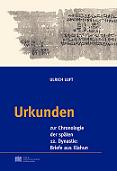Das Archiv von Illahun, das wichtigste Tempelarchiv vor der griechisch-römischen Zeit, datiert in die zweite Hälfte der 12. Dynastie. Der Fund zerfällt in zwei Teile, die im Abstand von zehn Jahren 1889/90 und 1899 gefunden worden sind. Der erste Teil befindet sich heute im Petrie Museum London, der zweite fast gänzlich im Berliner Museum. Hinsichtlich des Fundplatzes wird Illahun für die Londoner Papyri angenommen, während die Herkunft der zweiten Gruppe durch einen Survey in Illahun im Jahr 1899 fast als gesichert gelten darf. Die Bedeutung des Berliner Teils wird noch dadurch erhöht, dass in dem Tempeltagebuch aus dem Jahr 7 des Königs Sesostris III. das Datum des heliakischen Aufgangs des Sirius angegeben ist. Dieses Datum ist seit seinem Bekanntwerden immer wieder zum Ausgangspunkt für die Festlegung der ägyptischen Chronologie gemacht worden. Neben dieser Briefkopie, die 1992 in der ”Chronologischen Fixierung" publiziert worden ist, gibt es noch eine Menge von Briefen mit Monddaten, die zur Festlegung des siderischen Datums benutzt worden sind. Diese Briefe sind jedoch nicht nur wegen der eingestreuten Monddaten interessant, sie erlauben auch einen tiefen Einblick in das tägliche Leben des ägyptischen Mittleren Reiches.
The archive of el-Lahun, the most important temple-archive before the Greek-Roman Period, dates from the second half of the 12th dynasty. The find is divided in two parts that were found ten years apart in 1889/90 and 1899. The first part is now in the Petrie Museum London, the second one almost completely in the Berlin Museum. The London papyri are said to have come from el-Lahun, while the second find's origin was determined with almost complete certainy in a survey in 1899. The Berlin find concentrates fully on the process of the mortuary cult of the king
Sesostris II while the London papyri comprise items of a more individual character like legal documents household lists, contracts, even literary pieces. The Berlin find comprises documents of the daily cult in the mortuary temple of the King such as letters, temple-diaries, supply and festival lists. The significance of the Berlin part is made even greater by the fact that the date of the Heliacal Rise of Sirius is recorded in the temple-diary of the 7th year of King Sesostris III.
ISBN 978-3-7001-3300-1Print Edition
ISBN 978-3-7001-6643-6
Online Editiondoi:10.1553/0x000487ca
2006 (ISBN-13: 978-3-7001-3300-1), 167 Seiten, 38x30 cm, broschiert, Contributions to the Chronology of the Eastern Mediterranean VII, Denkschriften der Gesamtakademie XXXIV
€ 59,–




















